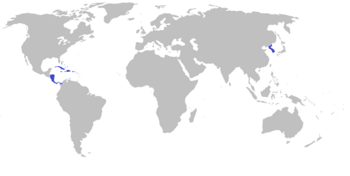Third Han: Difference between revisions
(Created page with "{{Infobox former country |native_name = 丙韓<br>Byeong Han (Korean)<br> |conventional_long_name = Third Han |government_type = {{wp|Monarchic}} {{wp|milita...") |
No edit summary |
||
| (2 intermediate revisions by the same user not shown) | |||
| Line 8: | Line 8: | ||
|event_start = [[Restoration of Han rule]] | |event_start = [[Restoration of Han rule]] | ||
|date_start = 15<sup>th</sup> December | |date_start = 15<sup>th</sup> December | ||
|event_end = [[ | |event_end = [[Japanese Annexation]] | ||
|date_end = 4<sup>th</sup> May | |date_end = 4<sup>th</sup> May | ||
|p1 = Kingdom of Daikon | |p1 = Kingdom of Daikon | ||
| Line 41: | Line 41: | ||
|stat_pop1 = 29,000,000 | |stat_pop1 = 29,000,000 | ||
}} | }} | ||
The '''Third Han''' (''{{wp|Korean language| | The '''Third Han''' (''{{wp|Korean language|Korean}}'': '''丙韓'''; ''Byeong Han'') was a nation that existed from the dissolvement of the Daikon in 1812, to 1905, when the Korea formally agreed to the provisions set out at the [[treaty of Fukuoka]]. | ||
The Third Han came into existence after the [[December Coup]], when military leader Cho Guk marched the Royal Army into the Royal Palace and ousted Ilban loyalists, proclaiming a new sovereign nation and restoring [[Han Clan | The Third Han came into existence after the [[December Coup]], when military leader Cho Guk marched the Royal Army into the Royal Palace and ousted Ilban loyalists, proclaiming a new sovereign nation and restoring [[Han Clan]] rule. Due to an unstable political state at home, the coup was met with little resistance by Japan, and all Japanese troops withdrew from all territories claimed by the new Han. | ||
The Third Han ceased to exist after the treaty of Fukuoka, which formally re-established Japanese rule over the Korean Peninsula and founded the [[Empire of Nin]]. | |||
Latest revision as of 01:55, 8 May 2021
Third Han 丙韓 Byeong Han (Korean) | |||||||||
|---|---|---|---|---|---|---|---|---|---|
| 1812–1905 | |||||||||
 The Third Han at its height in 1890 | |||||||||
| Capital | Hanseong | ||||||||
| Government | Monarchic military dictatorship | ||||||||
| Monarch | |||||||||
• 1812-1830 | King Sol | ||||||||
• 1830-1839 | Queen Samtae | ||||||||
• 1839-1856 | King Noksan | ||||||||
• 1856-1889 | King Namgung | ||||||||
• 1889-1905 | Queen Saebyung | ||||||||
| State Councellor | |||||||||
• 1812-1823 | Cho Guk (first) | ||||||||
• 1900-1905 | Park Sen (last) | ||||||||
| Legislature | National Diet | ||||||||
| History | |||||||||
| 15th December 1812 | |||||||||
| 4th May 1905 | |||||||||
| Population | |||||||||
• 1890 Estimate | 29,000,000 | ||||||||
| Currency | Won | ||||||||
| |||||||||
The Third Han (Korean: 丙韓; Byeong Han) was a nation that existed from the dissolvement of the Daikon in 1812, to 1905, when the Korea formally agreed to the provisions set out at the treaty of Fukuoka.
The Third Han came into existence after the December Coup, when military leader Cho Guk marched the Royal Army into the Royal Palace and ousted Ilban loyalists, proclaiming a new sovereign nation and restoring Han Clan rule. Due to an unstable political state at home, the coup was met with little resistance by Japan, and all Japanese troops withdrew from all territories claimed by the new Han.
The Third Han ceased to exist after the treaty of Fukuoka, which formally re-established Japanese rule over the Korean Peninsula and founded the Empire of Nin.
